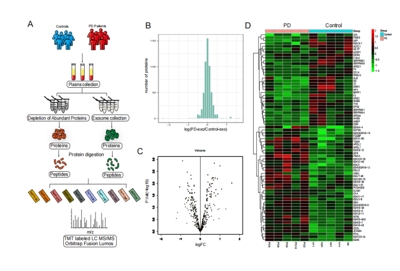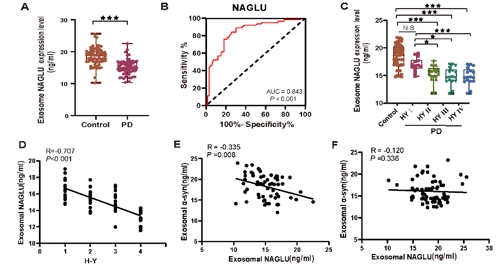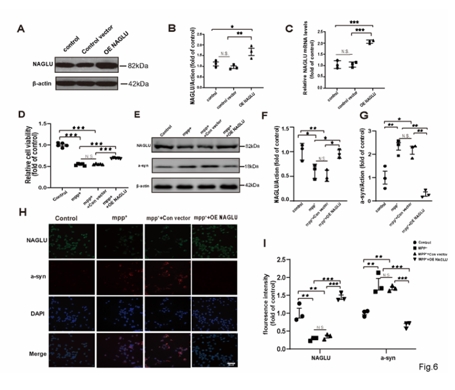NRR: 河北医科大学第二医院杨国锋团队运用蛋白质组学首次揭示外泌体N -乙酰- α -氨基葡萄糖酶在帕金森病中的作用及作为诊断标记物的潜力
撰写:赵媛,张译丹,刘新,张健,高雅,李淑月,常翠,刘向,杨国锋
帕金森病(Parkinson’s disease, PD)是最常见的引起老年人运动障碍的神经退行性疾病。 α-突触核蛋白(α-synuclein, α-syn)是PD发病机制中最重要的参与者之一,是路易小体的主要结构成分。α-syn聚集与路易小体的形成及多巴胺能神经元的死亡密切相关。外泌体(Exosomes,Exo)是一类由绝大多数细胞分泌的直径约50-150nm的外泌囊泡,具有穿越生物屏障的内在能力,可通过与受体细胞膜的融合从而将其内容物递送至受体细胞来参与细胞间的通讯[1]。既往研究发现相较于健康对照组,PD患者体液中的多种外泌体内含物出现表达差异,表明外泌体是可靠的PD生物标志物载体[2]。N -乙酰- α -氨基葡萄糖苷酶(NAGLU)是降解糖胺聚糖硫酸肝素所必需的溶酶体水解酶, 其突变可引起粘多糖病IIIB。已有研究表明粘多糖病IIIB患者大脑α-syn的积累,且NAGLU (rs2071046)基因多态性与PD患病风险相关,但NAGLU是否在PD中发挥致病作用仍不明确[3,4]。因此本研究应用基于串联质谱标签(TMT)的质谱技术分析PD患者和健康对照的血浆外泌体的蛋白质组学特征,评估外泌体差异表达蛋白-NAGLU在PD中诊断价值,并在体内外探讨NAGLU对α-syn表达的调控作用,为发现新型PD生物标志物和治疗靶点提供新思路。
河北医科大学第二医院杨国锋团队在《中国神经再生研究(英文)》(Neural Regeneration Research)2025年第10期发表了研究论文。该研究中,作者鉴定了帕金森病患者和健康对照的血浆外泌体的差异蛋白质谱,发现帕金森病患者血浆外泌体N -乙酰- α -氨基葡萄糖苷酶(NAGLU)水平明显降低。体外研究进一步发现1-甲基-4-苯基吡啶离子(MPP+)处理后细胞外泌体NAGLU水平显著低于未处理组。此外,在体内外PD模型(MPP+处理的N2A细胞和α-syn过表达SH-SY5Y细胞)中,NAGLU在细胞水平的表达也显著降低,且过表达NAGLU还可显著降低MPP+处理细胞的神经毒性及α-syn的表达水平。该研究带来的启示:外泌体NAGLU有望成为帕金森病诊疗的新型靶标,其在帕金森病中的致病作用可能与调控α-syn表达相关。赵媛与张译丹为论文共同第一作者,杨国锋教授为论文通讯作者。
帕金森病是最常见的引起老年人运动障碍的神经退行性疾病。目前仍缺乏PD的早期诊疗靶标。该研究首先应用基于串联质谱标签(TMT)的质谱技术分析PD患者和健康对照的血浆外泌体的差异蛋白质谱,发现相比于正常对照组,血浆外泌体NAGLU水平在PD患者中显著降低(图1),且外泌体NAGLU水平随着Hoehn—Yahr(H-Y)分期的增加而下降,因此外泌体NAGLU具有成为新型PD生物标志物的潜力(图2)。另外,在MPP+处理细胞和α-syn过表达细胞及其分泌细胞外泌体中NAGLU表达量均也均显著下调。既往研究表明在NAGLU突变引起的粘多糖病III患者大脑中可观察到α-syn积累[3]。因此,该研究进一步研究在PD中NAGLU是否可影响α-syn表达及累积。结果表明,在MPP+处理细胞中过表达NAGLU可降低α-syn在蛋白及mRNA表达水平(图3)。因此,该研究首次发现上调NAGLU可以减轻MPP+引起的细胞损伤和下调α-syn表达,并且外泌体NAGLU可能成为PD诊断新型标记物。

图1 基于TMT-定量的蛋白质组学分析发现,取log2|FC|>0.26和P < 0.05作为筛选条件,PD与健康组血浆外泌体样本的差异表达蛋白76个,其中上调41个,下调35个。NAGLU为显著下调蛋白之一。

图2 相比于正常对照组,血浆外泌体NAGLU水平在PD患者中显著降,且外泌体NAGLU水平随着Hoehn—Yahr(H-Y)分期的增加而下降。

图3 在MPP+干预N2A细胞中上调NAGLU表达可以减轻MPP+引起的细胞毒性损伤,降低α-syn表达。
因此,该研究运用蛋白质组学技术系统分析帕金森病与正常对照组差异表达蛋白,首次发现外泌体NAGLU在帕金森病患者血浆中水平低于正常对照人群,且与患者Hoehn—Yahr(H-Y)分期成负相关。不仅如此,该研究首次发现上调NAGLU可以减轻MPP+引起的细胞损伤及降低α-syn表达。综上所述,NAGLU可能成为帕金森病治疗的新靶点,外泌体NAGLU具有成为新型PD诊断标记物的潜力。
当然该研究也存在一定性局限性。首先研究的样本量较小,缺乏大样本量的验证,不能很好客观评价外泌体NAGLU在PD中的诊断价值;其次,在以后大样本量中评估NAGLU作为PD临床指标的准确性时,应尽量多的收集患者一般和临床信息,如FDG-PET, DAT-PET表现、睡眠情况及焦虑和抑郁水平等。第三,该研究是探索性的初步研究,仅在体外和MPTP小鼠中观察NAGLU对α-syn表达的影响。接下来,需要进一步在α-syn/NAGLU转基因小鼠模型的研究探索NAGLU调控α-syn水平的具体机制,全面研究NAGLU在PD疾病进展中的作用。
原文链接:XXX
参考文献:
[1] Andersen HH, Duroux M, Gazerani P. MicroRNAs as modulators and biomarkers of inflammatory and neuropathic pain conditions. Neurobiol Dis. 2014;71:159-168.
[2] Kluge A, Bunk J, Schaeffer E, et al. Detection of neuron-derived pathological alpha-synuclein in blood. Brain. 2022;145:3058-3071.
[3] Hamano K, Hayashi M, Shioda K, et al. Mechanisms of neurodegeneration in mucopolysaccharidoses II and IIIB: analysis of human brain tissue. Acta Neuropathol. 2008;115:547-559.
[4]Winder-Rhodes SE, Garcia-Reitbock P, Ban M, et al. Genetic and pathological links between Parkinson's disease and the lysosomal disorder Sanfilippo syndrome. Mov Disord. 2012;27:312-315.


